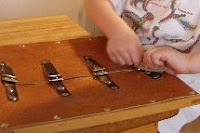
 Oh, if only manufacturers of children's winter clothing were as particular about fasteners as are Montessori teachers! At times it seems as though children's clothes are designed on another planet. Many of the zippers, buttons, snaps and clasps used are beyond the skills of many adults let alone the fingers of a 3 year old! It breaks my heart to watch our youngest students struggle and strain with poorly made plastic fasteners. After months spent practising with the dressing frames the light of success dims in a child's eyes when he has to turn in frustration and cry "I can't do this!".
Oh, if only manufacturers of children's winter clothing were as particular about fasteners as are Montessori teachers! At times it seems as though children's clothes are designed on another planet. Many of the zippers, buttons, snaps and clasps used are beyond the skills of many adults let alone the fingers of a 3 year old! It breaks my heart to watch our youngest students struggle and strain with poorly made plastic fasteners. After months spent practising with the dressing frames the light of success dims in a child's eyes when he has to turn in frustration and cry "I can't do this!".
This is where parents can help their children retain that feeling of success. When a new coat or jacket needs to be purchased, take the child with you. (This is especially important if you buy gently used clothing, as I do.) Restrain yourself from purchasing something that is "cute" if your child can't fasten the garment without help. In addition, take some time at home to practise with the new clothes before the child actually has to wear the garment. A few minutes spent zipping up a new coat one quiet afternoon may make for an easier time on busy mornings when everyone is rushing to get out the door. The more we can help children build on their successes, the more independent they will become.
No comments:
Post a Comment